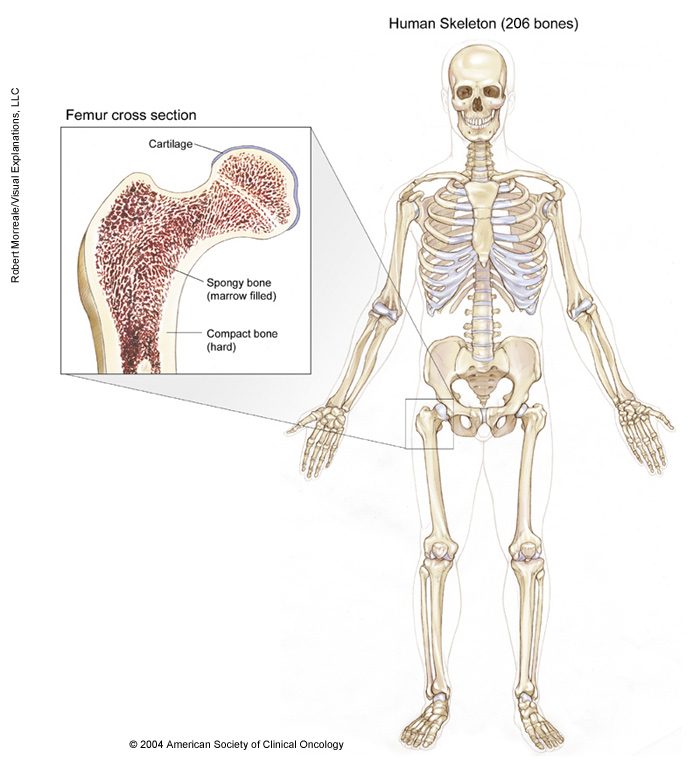Approved by the Cancer.Net Editorial Board, 09/2022
About bones
The adult human skeletal system is made up of 206 bones. Bones protect the internal organs, allow people to stand upright, and attach to muscles, which allow movement. Bones are connected to other bones by bands of tough, fibrous tissue called ligaments. Cartilage covers and protects the joints where bones come together. Bones are hollow and filled with bone marrow, which is the spongy, red tissue that produces blood cells. The cortex is the hard, outer portion of the bone.
Bone consists of collagen, which is a soft, fibrous tissue, and calcium phosphate, a mineral that helps harden and strengthen the bone. There are 3 types of bone cells:
- Osteoclasts: Cells that break down and remove old bone.
- Osteoblasts: Cells that build new bone.
- Osteocytes: Cells that carry nutrients to the bone.

About bone sarcoma
Cancer can start in any part of any bone. Cancer begins when healthy cells in the bone change and grow out of control, forming a mass called a tumor. A bone tumor can be cancerous or benign.
A cancerous tumor is malignant, meaning it can grow and spread to other parts of the body. A malignant tumor can destroy the bone and spread to nearby tissue. If these bone tumor cells get into the bloodstream, they can spread to other parts of the body, especially the lungs, through a process called metastasis.
A benign tumor means the tumor can grow, but it will not spread to other parts of the body. Even though a benign tumor does not spread outside the bone, it can grow large enough to press on surrounding tissue, weaken the bone, and cause the bone to fracture.
There are different types of connective tissue cancers of the bone:
- Chondrosarcoma. Chondrosarcoma is cancer of the cartilage. It is more common in adults.
- Chordoma. This type of bone sarcoma typically starts in part of the spinal cord.
- Ewing sarcoma. Ewing sarcoma is most common in children and younger adults. Ewing sarcoma is unusual in that it can occur in bone or soft tissue.
- Osteosarcoma. Osteosarcoma is most common in children and younger adults, although it can occur in older adults. Refer to the guide to osteosarcoma to learn more.
It is rare for soft-tissue sarcoma to begin in the bone, but when it does, it can cause different types of cancer, such as:
- Undifferentiated pleomorphic sarcoma (UPS). UPS is an uncommon bone tumor, most closely related to osteosarcoma (see above). UPS of bone is usually found in adults.
- Fibrosarcoma. This type of soft-tissue sarcoma is also more common among adults, particularly during middle age.
There are other cancers that start in bone marrow, such as myeloma or leukemia. These are different from bone sarcoma and are discussed in their own guides on this website.
Cancer that has spread to the bone
Cancer that started in another area of the body and has spread to the bone is called metastatic cancer, not bone cancer or bone sarcoma. While this section contains information about primary bone sarcoma, which is cancer that begins in the bone, it is much more common for other cancers, such as breast, lung, or prostate cancers, to spread to the bone. For example, lung cancer that has spread to the bone is called metastatic lung cancer.
For information about cancer that has started in another part of the body and spread to the bone, please see the information for that type of cancer or read a fact sheet about when cancer spreads to the bone (PDF).